
BartolomeoMontagna was an Italian Renaissance painter who mainly worked in Vicenza. He also produced works in Venice, Verona, and Padua. He is most famous for his many Madonnas and his works are known for their soft figures and depiction of eccentric marble architecture. He is considered to be heavily influenced by Giovanni Bellini, in whose workshop he might have worked around 1470. Benedetto Montagna, a productive engraver, was his son and pupil and active until about 1540. He was mentioned in Vasari's Lives as a student of Andrea Mantegna but this is widely contested by art historians.

Alessandro Bonvicino, more commonly known as Moretto, or in Italian Il Moretto da Brescia, was an Italian Renaissance painter from Brescia, where he also mostly worked. His dated works span the period from 1524 to 1554, but he was already described as a master in 1516. He was mainly a painter of altarpieces that tend towards sedateness, mostly for churches in and around Brescia, but also in Bergamo, Milan, Verona, and Asola; many remain in the churches they were painted for. The majority of these are on canvas, but a considerable number, including some large pieces, are created on wood panels. There are only a few surviving drawings from the artist.
Andrea Solari (1460–1524) was an Italian Renaissance painter of the Milanese school. He was initially named Andre del Gobbo, but more confusingly as Andrea del Bartolo a name shared with two other Italian painters, the 14th-century Siennese Andrea di Bartolo, and the 15th-century Florentine Andrea di Bartolo.

Giovanni Battista Cima, also called Cima da Conegliano, was an Italian Renaissance painter, who mostly worked in Venice. He can be considered part of the Venetian school, though he was also influenced by Antonello da Messina, in the emphasis he gives to landscape backgrounds and the tranquil atmosphere of his works. Once formed his style did not change greatly. He mostly painted religious subjects, often on a small scale for homes rather than churches, but also a few, mostly small, mythological ones.

Vincenzo Foppa was an Italian painter from the Renaissance period. While few of his works survive, he was an esteemed and influential painter during his time and is considered the preeminent leader of the Early Lombard School. He spent his career working for the Sforza family, Dukes of Milan, in Pavia, as well as various other patrons throughout Lombardy and Liguria. He lived and worked in his native Brescia during his later years.

The Pinacoteca di Brera is the main public gallery for paintings in Milan, Italy. It contains one of the foremost collections of Italian paintings from the 13th to the 20th century, an outgrowth of the cultural program of the Brera Academy, which shares the site in the Palazzo Brera.

The Madonna della Seggiola or The Madonna della Sedia is an oil on panel Madonna painting by the High Italian Renaissance artist Raphael, executed c. 1513–1514, and housed at the Palazzo Pitti Collection in Florence, Italy. Although there is documentation on its arrival to its current location, Palazzo Pitti, it is still unknown who commissioned the painting; however, it has been in the Medici family since the 16th century.
The decade of the 1470s in art involved some significant events.
The decade of the 1460s in art involved some significant events.

This article about the development of themes in Italian Renaissance painting is an extension to the article Italian Renaissance painting, for which it provides additional pictures with commentary. The works encompassed are from Giotto in the early 14th century to Michelangelo's Last Judgement of the 1530s.

Giampietrino, probably Giovanni Pietro Rizzoli, was a north Italian painter of the Lombard school and Leonardo's circle, succinctly characterized by S. J. Freedberg as an "exploiter of Leonardo's repertory."
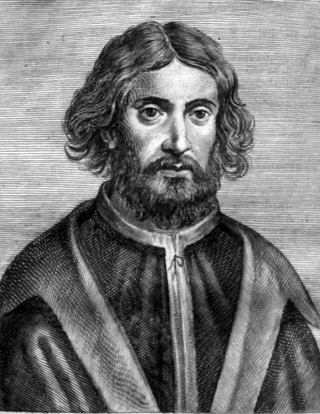
Palma Vecchio, born Jacopo Palma, also known as Jacopo Negretti, was a Venetian painter of the Italian High Renaissance. He is called Palma Vecchio in English and Palma il Vecchio in Italian to distinguish him from Palma il Giovane, his great-nephew, who was also a painter.
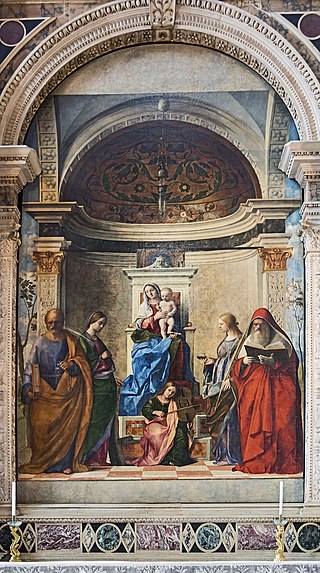
The San Zaccaria Altarpiece is a painting by the Italian Renaissance painter Giovanni Bellini, executed in 1505 and located in the church of San Zaccaria, Venice.
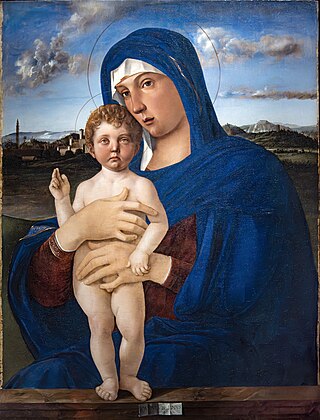
The Contarini Madonna is an oil painting by the Italian Renaissance master Giovanni Bellini, dating from c. 1475–1480 now in the Gallerie dell'Accademia in Venice.
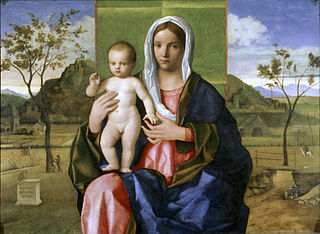
The 'Madonna and Child or Madonna with the Christ Child Blessing is a 1510 oil-on-panel painting by the Italian Renaissance master Giovanni Bellini, painted when he was already in his eighties but still responding to new developments in painting. It is similar to the 1505 Madonna del Prato and the 1509 Madonna and Child. It is now in the Pinacoteca di Brera in Milan.

The Greek Madonna is a 1460–1470 tempera-on-panel painting by the Italian Renaissance artist Giovanni Bellini. It is named after the Greek monograms at top left and top right and after the major influence of Byzantine icons on the painting. The Christ Child holds a golden apple, perhaps referring to the Judgement of Paris and to Mary as the "new Venus".

The Madonna and Child with St. John the Baptist and a Female Saint or the Giovanelli Sacred Conversation is an oil painting on panel by the Italian Renaissance master Giovanni Bellini, dated to before 1504. It is kept in the Gallerie dell'Accademia of Venice.
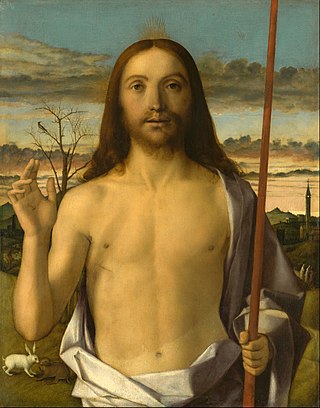
Christ Blessing is a painting by Italian Renaissance master Giovanni Bellini created around the year 1500.

Count Guglielmo Lochis was an Italian nobleman, politician, art collector and art connoisseur.
















